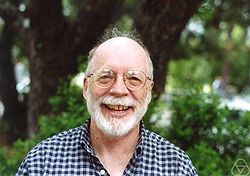Robion Kirby

Robion Cromwell Kirby (born February 25, 1938 in Chicago ) is an American mathematician who deals with low-dimensional topology.
Live and act
Kirby received his bachelor's degree in 1959, his master's degree in 1960 and received his doctorate in 1965 from the University of Chicago with S. Eldon Dyer ( Smoothing locally flat imbeddings ). He was then an assistant professor at the University of California, Los Angeles from 1965 to 1969 . He has been Professor of Mathematics at the University of California, Berkeley since 1971 .
With Laurent Siebenmann he discovered the Kirby-Siebenmann invariants in the classification of PL structures of topological manifolds. These have a PL structure if and only if a class in the fourth cohomology group of the manifold vanishes (the Kirby-Siebenmann class). The PL structures are further classified by elements of the third cohomology class. He developed the Kirby calculus to describe three- and four-dimensional topological manifolds with Surgery (dissection, surgery) of framed tangles ( "framed left").
He is also well-known for his list of open problems in low-dimensional topology (he even received the National Academy of Sciences reviews award for it). For his part, Kirby (and Siebenmann) had solved four of seven problems with their work in the early 1970s, which the leading topologist John Milnor saw as the toughest open problems in geometric topology in 1963.
In 1971 he received the Oswald Veblen Prize of the American Mathematical Society , of which he is a fellow. In 1974 he was a Guggenheim Fellow. In 2001 he was accepted into the National Academy of Sciences , whose NAS Award for Scientific Reviewing he had received in 1995. In 1970 he was invited speaker at the International Congress of Mathematicians in Nice ( Some conjectures about four-manifolds ).
His doctoral students include Tomasz Mrowka , Selman Akbulut and Robert Gompf .
Fonts
- Topology of Four Manifolds. Lecture Notes in Mathematics, Springer-Verlag, 1989.
- with Laurence Taylor: A survey of 4-manifolds through the eyes of surgery. 1998.
- Kirby: List of problems in low dimensional topology. 380 pages, Postscript file, gzipped.
- Kirby, Siebenmann: Foundational Essays on Topological Manifolds, Smoothings, and Triangulations. Annals of Mathematical Studies, Princeton 1977, PDF file.
Web links
- Literature by and about Robion Kirby in the catalog of the German National Library
- Homepage
- Robion Kirby in the Mathematics Genealogy Project (English)
- Biography from the Proceedings of the Kirbyfest, doi : 10.2140 / gtm.1999.2 , on his 60th birthday in 1998.
References and comments
- ↑ dates of birth according to Pamela Kalte u. a. American Men and Women of Science , Thomson Gale 2005
- ↑ PL stands for piecewise linear , which can be represented piecewise with linear functions using an atlas.
- ↑ which refuted the assumption of triangulation
- ↑ which refutes the “main presumption” (uniqueness of the triangulation of manifolds, Ernst Steinitz , Heinrich Tietze 1908 except for homeomorphism ), which Andrew Casson and Dennis Sullivan already showed around 1967; Kirby and Siebenmann's studies revealed an obstruction in five or more dimensions.
- ↑ which was based on Kirby's "torus trick"
| personal data | |
|---|---|
| SURNAME | Kirby, Robion |
| ALTERNATIVE NAMES | Kirby, Robion Cromwell (full name) |
| BRIEF DESCRIPTION | American mathematician |
| DATE OF BIRTH | February 25, 1938 |
| PLACE OF BIRTH | Chicago |